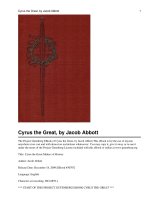minerals ppt great explaination
Bạn đang xem bản rút gọn của tài liệu. Xem và tải ngay bản đầy đủ của tài liệu tại đây (2.04 MB, 11 trang )
In 2008, crystals up to
39 feet long were
found in a cave in
Mexico at a depth of
1000 feet. The cave is
extremely hot, with air
temperatures reaching
136 °F with 90 to 99 %
humidity. The cave is
relatively unexplored
due to these
conditions. Without
proper protection,
people can only
endure about ten
minutes of exposure at
a time. See the suits
Mineral Formation
The Earth’s crust is made up of two
things:
• Minerals and Rocks
Coal
Gneiss
Scoria
Rocks are
Minerals are
individual crystals
of all the same stuff
combinations
of minerals
***You should see lots of different
minerals in every single rock
Main Concept: Minerals are the
What
is
a
mineral?
building blocks of rocks!
There are five main criteria for
something to be a mineral:
a) It must be solid
a) It must occur naturally (not man-made)
b) It is made of non-living material (never alive)
c) It has a definite chemical formula (NaCl=salt)
d) It has a crystal structure (Precious?)
Examples:
***Notice how each is one single type of crystal!
• Amethyst
•
Galena
Calcite
Gold
Garnet
Pyrite
Where do minerals come from?
Mineral crystals can form in two main ways:
From stuff
dissolved in liquids
(Evaporation & Hot Water)
From Cooling
molten material
Minerals & Crystals from
Magma & Lava
“Extrusive” Cooling:
Lava cools Fast
(Short Time = Small Crystals)
•Minerals form from hot magma as it
cools inside the crust, or as lava cools
on the surface.
•When these liquids cool to a solid, they
form crystals (minerals).
•Size of the crystal depends on time it
takes to freeze into a solid.
“Intrusive” Cooling:
Magma cools slowly
(Long Time = Large Crystals)
Minerals
Minerals Crystal
Crystal Size
Size
When the hot material cools fast, it has
smaller crystal size. When it cools
slowly, it has large crystals.
Granite
You can see
individual crystals
in Granite
= cooled slowly
Rhyolite
You can’t see many
individual crystals in Rhyolite
= cooled very fast
Minerals formed by Evaporation
Some minerals form when
solutions/mixtures evaporate:
When water evaporates, it leaves behind the
stuff that’s dissolved in it.
The longer it takes to evaporate, the larger the
crystal.
i.e. salt & water – ocean,
Halite, Gypsum, Calcite.
***All the white stuff = salt mineral crystals that formed
when the water of this lake evaporated.
The mineral material was left behind
These salt crystals formed from
salt water because as the water
evaporated, the salt wasn’t
dissolved anymore. So the
chemical energy in salt takes
over and crystals form.
Do you notice the characteristic
cubic crystalline shapes?
How do we
identify Minerals?
We use the different physical and chemical properties
of the mineral to identify it from other different minerals
Luster: Describes how light is reflected from a minerals surface.
Streak: Is the color of the minerals powder when dragged across a surface.
Crystal shape: Different minerals make different crystal shapes
Hardness: Hardness is determined by a “scratch test”.
Color: Every mineral has some natural color…ex: Gold, Blue, Clear…
Etc: There are many other types of properties we use but these are the big ones
Special Properties
• Some minerals display strange properties.
•
These can include: Magnetism, fluorescence, and reactivity.
Fizzing!
The particles of minerals
of this rock act like magnets
These minerals glow
The minerals in
in the dark.
this rock react
A black light really brings it out!
with acid









